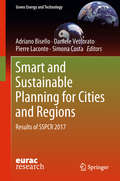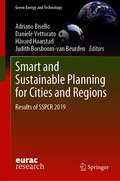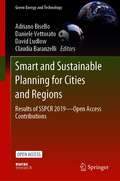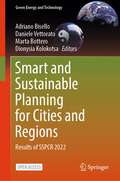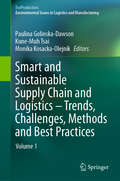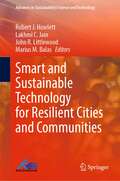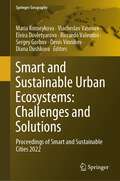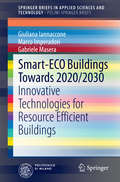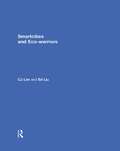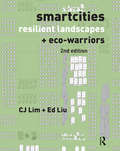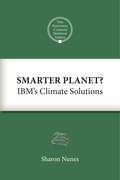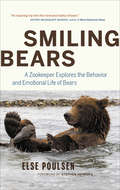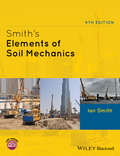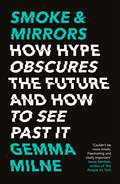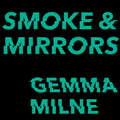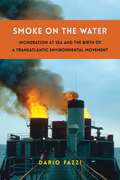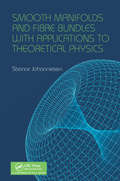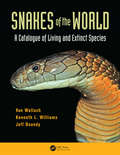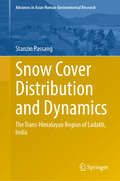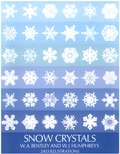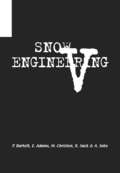- Table View
- List View
Smart and Sustainable Cities and Buildings (Contemporary Urban Design Thinking Ser.)
by Rob Roggema Anouk RoggemaThis book brings together the papers presented at the Smart and Sustainable Built Environments Conference, 2018 (SASBE).This latest research falls into two tracks: smart and sustainable design and planning cities; and the technicalities of smart and sustainable buildings. The growth of smart cities is evident, but not always linked to sustainability. This book gives an overview of the latest academic developments in increasing the smartness and sustainability of our cities and buildings. Aspects such as inclusivity, smart cities, place and space, the resilient city, urbanity and urban ecology are prominently featured in the design and planning part of the book; while energy, educational buildings, comfort, building design, construction and performance form the sub-themes of the technical part of the book. This book will appeal to urban designers, architects, urban planners, smart city designers and sustainable building experts.
Smart and Sustainable Planning for Cities and Regions
by Richard Stephens Adriano Bisello Daniele Vettorato Pietro EliseiThis book presents cutting-edge work on innovative planning methodologies, tools and experiences aimed at supporting the transition of our cities and regions towards a more smart and sustainable dimension. This book comprises a selection of the best papers presented at the international conference "Smart and Sustainable Planning for Cities and Regions 2015", held in November 2015 in Bolzano, Italy. Contributions from different research fields within urban and regional planning from the scientific as well as the professional community are presented: energy planning for cities and regions, how to couple the energy-climate goals with the development or renovation of the built environment and how to tackle the vulnerability to climate change; smart and sustainable technologies, big data, integrated infrastructures and mobility management, from holistic geospatial tools to innovative apps and Internet of Things; benefits, costs and opportunities of urban transition toward a more smart and sustainable dimension, accounting and assessment of values and trade-offs within the decision making processes; governance for smart and sustainable growth, fostering place-based policy-making, active and effective stakeholders' participation, co-production and public-private partnerships; cooperation and demonstration projects: their role in fostering the adoption of new approaches and technologies, towards the development of win-win solutions.
Smart and Sustainable Planning for Cities and Regions: Results Of Sspcr 2015 (Green Energy And Technology)
by Adriano Bisello Daniele Vettorato Pierre Laconte Simona CostaThis book comprises a selection of the top contributions presented at the second international conference “Smart and Sustainable Planning for Cities and Regions 2017”, held in March 2017 in Bolzano, Italy. Featuring forty-six papers by policy-makers, academics and consultants, it discusses current groundbreaking research in smart and sustainable planning, including the progress made in overcoming cities’ challenges towards improving the quality of life. Climate change adaptation and mitigation of global warming, generally identified as drivers of global policies, are just the “tip of the iceberg” when it comes to smart energy transition. Indeed, equally relevant towards this current transformation – and key topics in this volume – are ICTs, public spaces and society; next economy for the city; strategies and actions for good governance; urban-rural innovation; rethinking mobility. The book’s depth in understanding and insightfulness in re-thinking demonstrate the breaking of new ground in smart and sustainable planning. A new ground that policy-makers, academics and consultants may build upon as a bedrock for smart and sustainable planning.
Smart and Sustainable Planning for Cities and Regions: Results of SSPCR 2019 (Green Energy and Technology)
by Judith Borsboom-van Beurden Håvard Haarstad Adriano Bisello Daniele VettoratoThis book offers a selection of research papers and case studies presented at the 3rd international conference “Smart and Sustainable Planning for Cities and Regions”, held in December 2019 in Bolzano, Italy, and explores the concept of smart and sustainable planning, including top contributions from academics, policy makers, consultants and other professionals. Innovation processes such as co-design and co-creation help establish collaborations that engage with stakeholders in a trustworthy and transparent environment while answering the need for new value propositions. The importance of an integrated, holistic approach is widely recognized to break down silos in local government, in particular, when aimed at achieving a better integration of climate-energy planning. Despite the ongoing urbanization and polarization processes, new synergies between urban and rural areas emerge, linking development opportunities to intrinsic cultural, natural and man-made landscape values. The increasing availability of big, real-time urban data and advanced ICT facilitates frequent assessment and continuous monitoring of performances, while allowing fine-tuning as needed. This is valid not only for individual projects but also on a wider scale. In addition, and circling back to the first point, (big) urban data and ICT can be of enormous help in facilitating engagement and co-creation by raising awareness and by providing insight into the local consequences of specific plans. However, this potential is not yet fully exploited in standard processes and procedures, which can therefore lack the agility and flexibility to keep up with the pulse of the city and dynamics of society. The book provides a multi-disciplinary outlook based on experience to orient the reader in the giant galaxy of smart and sustainable planning, support the transposition of research into practice, scale up visionary approaches and design groundbreaking planning policies and tools.
Smart and Sustainable Planning for Cities and Regions: Results of SSPCR 2019—Open Access Contributions (Green Energy and Technology)
by Adriano Bisello Daniele Vettorato David Ludlow Claudia BaranzelliThis open access book offers a selection of research papers and case studies presented at the 3rd international conference “Smart and Sustainable Planning for Cities and Regions”, held in December 2019 in Bolzano, Italy, and explores the concept of smart and sustainable planning, including top contributions from academics, policy makers, consultants and other professionals. Innovation processes such as co-design and co-creation help establish collaborations that engage with stakeholders in a trustworthy and transparent environment while answering the need for new value propositions. The importance of an integrated, holistic approach is widely recognized to break down silos in local government, in particular, when aimed at achieving a better integration of climate-energy planning. Despite the ongoing urbanization and polarization processes, new synergies between urban and rural areas emerge, linking development opportunities to intrinsic cultural, natural and man-made landscape values. The increasing availability of big, real-time urban data and advanced ICT facilitates frequent assessment and continuous monitoring of performances, while allowing fine-tuning as needed. This is valid not only for individual projects but also on a wider scale. In addition, and circling back to the first point, (big) urban data and ICT can be of enormous help in facilitating engagement and co-creation by raising awareness and by providing insight into the local consequences of specific plans. However, this potential is not yet fully exploited in standard processes and procedures, which can therefore lack the agility and flexibility to keep up with the pulse of the city and dynamics of society. The book provides a multi-disciplinary outlook based on experience to orient the reader in the giant galaxy of smart and sustainable planning, support the transposition of research into practice, scale up visionary approaches and design groundbreaking planning policies and tools.
Smart and Sustainable Planning for Cities and Regions: Results of SSPCR 2022 (Green Energy and Technology)
by Dionysia Kolokotsa Adriano Bisello Daniele Vettorato Marta BotteroThis open access book includes a selection of innovative contributions presented at the 4th international conference “Smart and Sustainable Planning for Cities and Regions 2022”, held in Bolzano, Italy in July 2022. Featuring 10 papers by academics and consultants, strongly rooted in practical experiences and international projects, it discusses current ground-breaking research in innovative and sustainable planning for cities, with a focus on the environmental, economic, and social challenges associated with the global sustainability transition and energy systems integration. The contributions are illustrative of the richness of the issues discussed and the breadth of the emerging themes, including innovative business models for building and infrastructure at district level, integrated sustainability assessment schemes for Positive Energy Districts, a material flow accounting model for regional metabolism, energy communities as a lever to promote historical and landscape values, optimized and electrified last-mile logistics, multi-criteria decision analysis tools to redefine center/periphery relationships, a framework for socio-spatial analysis related to social practices, design principles and communication technologies improving both indoor and outdoor public spaces, augmented nature-based solution coupling the green elements with the latest technologies to deliver healthier and more appealing cities.
Smart and Sustainable Supply Chain and Logistics – Trends, Challenges, Methods and Best Practices: Volume 1 (EcoProduction)
by Paulina Golinska-Dawson Kune-Muh Tsai Monika Kosacka-OlejnikThis book discusses the critical contemporary issues of sustainability and integration of physical and information flow. It explores the digitalization of logistics processes and the need for a more integrated and a seamless cooperation in supply chain management, which are dominant trends in business practice. Moreover, it examines how the pressure for CO2 emission reductions and more resource- efficient business models influences the organization of logistics operations on both a local and global scale, demonstrating that integrating physical and cyber systems is necessary to achieve a more environmentally friendly, safe logistics and supply chain operations. In the individual chapters, the authors discuss the new qualitative and quantitative theoretical methods and models and also analyze case studies from business practice. This book provides valuable insights for academics, Ph.D. students and practitioners wishing to deepen their understanding of logistics operations and management.
Smart and Sustainable Technology for Resilient Cities and Communities (Advances in Sustainability Science and Technology)
by Lakhmi C. Jain Robert J. Howlett John R. Littlewood Marius M. BalasThis book is a collection of extended versions of papers presented at the KES Covid-19 Challenge international summit. The book focusses on technological, economic, and social developments to combat the effects of global and local disasters as well as the ways in which the recovery from Covid can be used to build more resilient and sustainable communities, industry, and improve the environment. It also discusses the global challenges of human-influenced climate change. There are chapters on making cities and communities more resilient through energy self-sufficiency, food production, resilient housing and buildings, human health and intelligent systems e.g. for forecasting and prediction.
Smart and Sustainable Urban Ecosystems: Proceedings of Smart and Sustainable Cities 2022 (Springer Geography)
by Riccardo Valentini Elvira Dovletyarova Viacheslav Vasenev Maria Korneykova Sergey Gorbov Denis Vinnikov Diana DushkovaThis book provides multidisciplinary approaches to smart and sustainable urban ecosystems. Urbanization is a global tendency, and up to 70% of the world population is projected to live in cities by 2050. How will this rapid urbanization alter the face of the world? What are the environmental consequences of megacities’ expansion? What are smart solutions to make life in cities safe, comfortable, and environmentally friendly? These and other important questions are addressed by the conference Smart and Sustainable Cities (SSC). This year’s theme for the conference will be « Sustainable urban ecosystems: challenges and solutions». Megapolises are complex ecosystems. Air and water quality, vegetation, and soils in megapolises are exposed to anthropogenic influence. Studying negative environmental consequences of the anthropogenic and technogenic pressures is among the key tasks of urban ecology and environmental impact assessment. Advanced approaches and smart technologies to monitor, model, and assess environmental consequences and risks in megapolises will be widely discussed at the conference. Searching for solutions of the environmental problems of modern megapolises will be the key point of the conference. Successful experiences of sustainable urban development and nature-based solutions to support climate adaptation, carbon neutrality, and human health will be presented in the conference proceedings.
Smart-ECO Buildings towards 2020/2030
by Giuliana Iannaccone Marco Imperadori Gabriele MaseraThe book aims to provide a basis for design and construction of resource-efficient buildings. The main concepts follow the vision of a European Sustainable Building as defined in the 2-years Smart-ECO research project funded by European Commission under the Sixth Framework Program. The focus is concentrated on innovations enabling the building sector to meet the requirements originating from the sustainability concept. Innovation is considered at different scales: micro (product, service and process), meso (sector, supply chain, region and system) and macro (economy-wide). Furthermore, the book focuses on aspects of relevance when striving to implement innovative technologies in building design: an integrated design process is indispensable to obtain a Smart-ECO building, independently of how effective a single technology is. Each chapter provides information on fundamental aspects of innovations towards resource-efficient buildings, shows examples and makes further guidance by way of a dedicated bibliography. Case studies are predominantly recent projects or experiences improving understanding and encouraging implementation.
Smartcities and Eco-Warriors: The Ecological Landscapes For Urban Resilience
by Cj Lim Ed LiuModern methods of agriculture have led to cities growing out of control and reducing the available agricultural land, threatening the sustainability of our food system. The previous mutually sustaining relationships of animals, humans and the land have been lost with the progress of industry. The Smartcity – an ecological symbiosis between nature, society and the built form – is the innovative response to contemporary problems from one of the world’s leading urban design and architectural thinkers. Addressing the problems of unchecked city growth, the idea of the Smartcity questions whether we could begin to live once again from first principles, focusing in on the inhabitants of the city. The holistic construct of the Smartcity is developed through a series of international case studies, some commissioned by government organisations, others speculative and polemic. Reframing the way people think about urban green space and the evolution of cities, CJ Lim and Ed Liu explore how the reintegration of agriculture in urban environments can cultivate new spatial practices and social cohesion in addition to food for our tables. Representing an emerging architectural voice in matters of environmental and social sustainability, Smartcities and Eco-warriors is a long overdue treatment of the subject from a designer’s perspective, and is essential reading for practitioners and students in the fields of architecture, urban planning, environmental engineering, landscape design, agriculture and sociology. An inspiration to government agencies and NGOs dealing with climate change, it also resonates with anyone concerned about cities, energy conservation and the future of food
Smartcities, Resilient Landscapes and Eco-Warriors: Resilient Landscapes + Eco-warriors
by Ed Liu CJ LimFollowing on from the success of the first edition, Smartcities + Eco-Warriors (2010), this book is the latest innovative response on urban resilience from one of the world’s leading urban design and architectural thinkers. An ecological symbiosis between nature, society and the built form, the Smartcity cultivates new spatial practices and creates diverse forms of resilient landscapes including and beyond urban agriculture. The notion of the Smartcity is developed through a series of international case studies, some commissioned by government organisations, others speculative and polemic. This second edition has nine new case studies, and additional ecological sustainability studies covering sensitivity, design criteria, and assessments for ecological construction plans. The book concludes with two new essays on the romance of trees and the empowering nature of resilient landscapes. Smartcities, Resilient Landscapes + Eco-warriors represents a crucial voice in the discourse of climate change and the potential opportunities to improve the ecological function of existing habitats or create new landscapes which are considered beneficial to local ecology and resilience. It is indispensable reading for practitioners and students in the fields of landscape, urban design, architecture and environmental engineering. An inspiration to government agencies and NGOs dealing with sustainability, this work also resonates with anyone concerned about cities, landscapes, food and water security, and energy conservation.
Smarter Planet?: IBM's Climate Solutions
by Eban Goodstein Sharon NunesOn October 19, 2011, Sharon Nunes participated in The National Climate Seminar, a series of webinars sponsored by Bard College's Center for Environmental Policy. The online seminars provide a forum for leading scientists, writers, and other experts to talk about critical issues regarding climate change. The series also opens a public conversation, inviting participants to ask questions and contribute their own thoughts. Sharon Nunes is Vice President of the Smarter Cities Strategy & Solutions program at IBM, working with municipal leaders to manage urban systems more efficiently. In her lecture, Nunes discussed the ability of smart grids and other information technology to save energy, time, and costs. Questions focused on the barriers to implementing these systems, and Nunes addressed ongoing challenges as well as successful programs. This E-ssential is an edited version of Nunes' talk and the subsequent question and answer session. While some material has been cut and some language modified for clarity, the intention was to retain the substance of the original discussion.
Smiling Bears: A Zookeeper Explores the Behavior and Emotional Life of Bears
by Else PoulsenAn award-winning zookeeper, author, and bear expert shares the insights she has gleaned from a career spent working with the majestic animals. Few people have known bears as intimately as Else Poulsen has. This remarkable book reveals the many insights about bears and their emotional lives that she has gained through her years of work with them. Always approaching each bear with the same two questions in mind—&“Who are you?&” and &“What can I do for you?&” —Poulsen has shared in the joy of a polar bear discovering soil under her paws for the first time in 20 years and felt the pride of a cub learning to crack nuts with her molars. She has also felt the hateful stare of one bear that she could not befriend, and she has grieved in the abject horror of captivity for a sun bear in Indonesia. Featuring photographs from Poulsen&’s personal collection, Smiling Bears provides an enlightening and moving portrait of bears in all their richness and complexity.Praise for Smiling Bears &“An inspiring trip into the mind and reality of bears.&” —Jeffrey Moussaieff Masson, author of When Elephants Weep &“If you doubt bears are able to smile, buy this book—it&’ll open your eyes and change the view.&” —Terry D. Debruyn, author of Walking with Bears &“A rare window of opportunity to begin to understand not only the incredible challenges that face these species but also the meaning of their existence in nature.&” —Robert Buchanan, president of Polar Bears International
Smith's Elements of Soil Mechanics
by Ian SmithThe 9th edition maintains the content on all soil mechanics subject areas - groundwater flow, soil physical properties, stresses, shear strength, consolidation and settlement, slope stability, retaining walls, shallow and deep foundations, highways, site investigation - but has been expanded to include a detailed explanation of how to use Eurocode 7 for geotechnical design. The key change in this new edition is the expansion of the content covering Geotechnical Design to Eurocode 7. Redundant material relating to the now defunct British Standards - no longer referred to in degree teaching - has been removed. Building on the success of the earlier editions, this 9th edition of Smith’s Elements of Soil Mechanics brings additional material on geotechnical design to Eurocode 7 in an understandable format. Many worked examples are included to illustrate the processes for performing design to this European standard. Significant updates throughout the book have been made to reflect other developments in procedures and practices in the construction and site investigation industries. More worked examples and many new figures have been provided throughout. The illustrations have been improved and the new design and layout of the pages give a lift. unique content to illustrate the use of Eurocode 7 with essential guidance on how to use the now fully published code clear content and well-organised structure takes complicated theories and processes and presents them in easy-to-understand formats book's website offers examples and downloads to further understanding of the use of Eurocode 7 www.wiley.com/go/smith/soil
Smoke & Mirrors: How Hype Obscures the Future and How to See Past It
by Gemma Milne'Stop following the news until you've read Gemma Milne's persuasive analysis of the hype and bullshit that distort our understanding of emerging science. As she shows, the starting point to grasping the genuine opportunities of AI, life sciences and climate tech is a healthy dose of critical thinking'David Rowan, founding editor of WIRED UK and author of Non-Bullshit Innovation: Radical Ideas from the World's Smartest Minds'Couldn't be more timely. Fascinating and vitally important'Jamie Bartlett, author of The People Vs Tech'A much-needed blast of fresh air! Gemma Milne expertly shows us how to separate the truth from the hype surrounding the emerging techs of today, and those of the near-tomorrow'Lewis Dartnell, author of Origins: How the Earth Made Us'I loved this book! This is exactly the sort of sceptical, cut-through-the crap-but-still-excited-about-what's-emerging book around tech innovation that's sorely needed, yet is so hard to find . . . essential reading for anyone who's serious about how real-world advances might be effectively harnessed to build a better future'Dr Andrew Maynard, scientist and author of Films from the Future and Future Rising'[A] vital contribution in a world where technological progress promises so much, but too often disappoints. If, like me, you believe that advances in science and technology are our best hope for solving the grand challenges of our times, this book is the indispensable guide to avoiding the mirages and the charlatans along the way'Matt Clifford, co-founder and CEO of Entrepreneur First'A refreshingly grown-up, clear-headed look at the interaction between science, technology and the media - readable without being dumbed down, acknowledging complexities without being heavy'Tom Chivers, author of The AI Does Not Hate You'ROBOTS WILL STEAL YOUR JOB!''AI WILL REVOLUTIONISE FARMING!''GENETIC EDITING WILL CURE CANCER!'Bombastic headlines about science and technology are nothing new. To cut through the constant stream of information and misinformation on social media, or grab the attention of investors, or convince governments to take notice, strident headlines or bold claims seem necessary to give complex, nuanced information some wow factor.But hype has a dark side, too.It can mislead. It can distract. It can blinker us from seeing what is actually going on.From AI, quantum computing and brain implants, to cancer drugs, future foods and fusion energy, science and technology journalist Gemma Milne reveals hype to be responsible for fundamentally misdirecting or even derailing crucial progress.Hype can be combated and discounted, though, if you're able to see exactly where, how and why it is being deployed.This book is your guide to doing just that.
Smoke & Mirrors: How Hype Obscures the Future and How to See Past It
by Gemma Milne'Stop following the news until you've read Gemma Milne's persuasive analysis of the hype and bullshit that distort our understanding of emerging science. As she shows, the starting point to grasping the genuine opportunities of AI, life sciences and climate tech is a healthy dose of critical thinking'David Rowan, founding editor of WIRED UK and author of Non-Bullshit Innovation: Radical Ideas from the World's Smartest Minds'Couldn't be more timely. Fascinating and vitally important'Jamie Bartlett, author of The People Vs Tech'A much-needed blast of fresh air! Gemma Milne expertly shows us how to separate the truth from the hype surrounding the emerging techs of today, and those of the near-tomorrow'Lewis Dartnell, author of Origins: How the Earth Made Us'I loved this book! This is exactly the sort of sceptical, cut-through-the crap-but-still-excited-about-what's-emerging book around tech innovation that's sorely needed, yet is so hard to find . . . essential reading for anyone who's serious about how real-world advances might be effectively harnessed to build a better future'Dr Andrew Maynard, scientist and author of Films from the Future and Future Rising'[A] vital contribution in a world where technological progress promises so much, but too often disappoints. If, like me, you believe that advances in science and technology are our best hope for solving the grand challenges of our times, this book is the indispensable guide to avoiding the mirages and the charlatans along the way'Matt Clifford, co-founder and CEO of Entrepreneur First'A refreshingly grown-up, clear-headed look at the interaction between science, technology and the media - readable without being dumbed down, acknowledging complexities without being heavy'Tom Chivers, author of The AI Does Not Hate You'ROBOTS WILL STEAL YOUR JOB!''AI WILL REVOLUTIONISE FARMING!''GENETIC EDITING WILL CURE CANCER!'Bombastic headlines about science and technology are nothing new. To cut through the constant stream of information and misinformation on social media, or grab the attention of investors, or convince governments to take notice, strident headlines or bold claims seem necessary to give complex, nuanced information some wow factor.But hype has a dark side, too.It can mislead. It can distract. It can blinker us from seeing what is actually going on.From AI, quantum computing and brain implants, to cancer drugs, future foods and fusion energy, science and technology journalist Gemma Milne reveals hype to be responsible for fundamentally misdirecting or even derailing crucial progress.Hype can be combated and discounted, though, if you're able to see exactly where, how and why it is being deployed.This book is your guide to doing just that.
Smoke & Mirrors: How Hype Obscures the Future and How to See Past It
by Gemma Milne'Stop following the news until you've read Gemma Milne's persuasive analysis of the hype and bullshit that distort our understanding of emerging science. As she shows, the starting point to grasping the genuine opportunities of AI, life sciences and climate tech is a healthy dose of critical thinking'David Rowan, founding editor of WIRED UK and author of Non-Bullshit Innovation: Radical Ideas from the World's Smartest Minds'Couldn't be more timely. Fascinating and vitally important'Jamie Bartlett, author of The People Vs Tech'A much-needed blast of fresh air! Gemma Milne expertly shows us how to separate the truth from the hype surrounding the emerging techs of today, and those of the near-tomorrow'Lewis Dartnell, author of Origins: How the Earth Made Us'I loved this book! This is exactly the sort of sceptical, cut-through-the crap-but-still-excited-about-what's-emerging book around tech innovation that's sorely needed, yet is so hard to find . . . essential reading for anyone who's serious about how real-world advances might be effectively harnessed to build a better future'Dr Andrew Maynard, scientist and author of Films from the Future and Future Rising'[A] vital contribution in a world where technological progress promises so much, but too often disappoints. If, like me, you believe that advances in science and technology are our best hope for solving the grand challenges of our times, this book is the indispensable guide to avoiding the mirages and the charlatans along the way'Matt Clifford, co-founder and CEO of Entrepreneur First'A refreshingly grown-up, clear-headed look at the interaction between science, technology and the media - readable without being dumbed down, acknowledging complexities without being heavy'Tom Chivers, author of The AI Does Not Hate You'ROBOTS WILL STEAL YOUR JOB!''AI WILL REVOLUTIONISE FARMING!''GENETIC EDITING WILL CURE CANCER!'Bombastic headlines about science and technology are nothing new. To cut through the constant stream of information and misinformation on social media, or grab the attention of investors, or convince governments to take notice, strident headlines or bold claims seem necessary to give complex, nuanced information some wow factor.But hype has a dark side, too.It can mislead. It can distract. It can blinker us from seeing what is actually going on.From AI, quantum computing and brain implants, to cancer drugs, future foods and fusion energy, science and technology journalist Gemma Milne reveals hype to be responsible for fundamentally misdirecting or even derailing crucial progress.Hype can be combated and discounted, though, if you're able to see exactly where, how and why it is being deployed.This book is your guide to doing just that.
Smoke on the Water: Incineration at Sea and the Birth of a Transatlantic Environmental Movement (Global America)
by Dario FazziThe U.S. government, military, and industry once saw ocean incineration as the safest and most efficient way to dispose of hazardous chemical waste. Beginning in the late 1960s, toxic chemicals such as PCBs and other harmful industrial byproducts were taken out to sea to be destroyed in specially designed ships equipped with high-temperature combustion chambers and smokestacks. But public outcry arose after the environmental and health risks of ocean incineration were exposed, and the practice was banned in the early 1990s.Smoke on the Water traces the rise and fall of ocean incineration, showing how a transnational environmental movement tested the limits of U.S. political and economic power. Dario Fazzi examines the anti-ocean-incineration movement that emerged on both sides of the Atlantic, arguing that it succeeded by merging local advocacy with international mobilization. He emphasizes the role played at the grassroots level by women, migrant workers, and other underrepresented groups who were at greatest risk. Environmental groups, for their part, gathered and shared evidence about the harms of at-sea incineration, building scientific consensus and influencing international debates.Smoke on the Water tells the compelling story of a campaign against environmental degradation in which people from marginalized communities took on the might of the U.S. military-industrial complex. It offers new insights into the transnational dimensions of environmental regulation, the significance of nonstate actors in international history, and the making of environmental justice movements.
Smooth Manifolds and Fibre Bundles with Applications to Theoretical Physics: An Introduction To Principles And Practice
by Steinar JohannesenThis book provides a systematic presentation of the mathematical foundation of modern physics with applications particularly within classical mechanics and the theory of relativity. Written to be self-contained, this book provides complete and rigorous proofs of all the results presented within. Among the themes illustrated in the book are differentiable manifolds, differential forms, fiber bundles and differential geometry with non-trivial applications especially within the general theory of relativity. The emphasis is upon a systematic and logical construction of the mathematical foundations. It can be used as a textbook for a pure mathematics course in differential geometry, assuming the reader has a good understanding of basic analysis, linear algebra and point set topology. The book will also appeal to students of theoretical physics interested in the mathematical foundation of the theories.
Snakes of the World: A Catalogue of Living and Extinct Species
by Van Wallach Kenneth L. Williams Jeff BoundySnakes of the World: A Catalogue of Living and Extinct Species-the first catalogue of its kind-covers all living and fossil snakes described between 1758 and 2012, comprising 3,509 living and 274 extinct species allocated to 539 living and 112 extinct genera. Also included are 54 genera and 302 species that are dubious or invalid, resulting in reco
Snow
by P. D. Eastman Roy MckieFrom the book: Snow! Snow! Come out in the snow. Snow! Snow! Just look at the snow! Come out! Come out! Come out in the snow. ... Picture descriptions add to the enjoyment of this book.
Snow Cover Distribution and Dynamics: The Trans-Himalayan Region of Ladakh, India (Advances in Asian Human-Environmental Research)
by Stanzin PassangThis comprehensive book examines a high mountain snow-covered expanse, spanning an investigation period of almost two decades. Leveraging advanced remote sensing and innovative algorithms, it meticulously maps the temporal and spatial dimensions of the snow cover extent of Ladakh, India. Rigorous statistical analyses, terrain examinations, and a groundbreaking snowfall prediction model contribute to a nuanced understanding. Grounded in empirical data, the volume not only enriches the research framework but also serves as a guiding compass for sustainable development amid the challenges of global warming. Seamlessly blending scientific rigour with a passion for discovery, the book invites readers to immerse themselves in a captivating snow-clad terrain, unlocking the secrets of its unique environment. Snow Cover Distribution and Dynamics: The Trans-Himalayan Region of Ladakh, India is divided into five chapters. The book begins with an introduction and a comprehensive overview of the materials and methods used in the study. The focus is on the application of the MODIS NDSI snow mapping algorithm, validated using Landsat images. The research also involves the development of innovative algorithms for the removal of clouds from MODIS data and for forecasting snowfall. The study is further enriched by on-ground measurements and the deployment of terrestrial cameras across diverse topographies for data validation. Chapter 3 presents the results, including observed patterns and trends of the snow cover distribution, and the application of an ARIMA model for future snowfall predictions. The final two chapters discuss the findings in detail, draw conclusions, and provide a future outlook, thereby offering a comprehensive understanding of the subject matter.
Snow Crystals
by W. A. Bentley W. J. HumphreysDid you ever try to photograph a snowflake? The procedure is very tricky. The work must be done rapidly in extreme cold, for even body heat can melt a rare specimen that has been painstakingly mounted. The lighting must be just right to reveal all the nuances of design without producing heat. But the results can be rewarding, as the work of W. A. Bentley proved. <p><p> For almost half a century, Bentley caught and photographed thousands of snowflakes in his workshop at Jericho, Vermont, and made available to scientists and art instructors samples of his remarkable work. In 1931, the American Meteorological Society gathered together the best of these photomicrographs, plus some slides of frost, glaze, dew on vegetation and spider webs, sleet, and soft hail, and a text by W. J. Humphreys, and had them published. That book is here reproduced, unaltered, and unabridged. Over 2,000 beautiful crystals on these pages reveal the wonder of nature's diversity in uniformity; no two are alike, yet all are based on a common hexagon. <p> The introductory text covers the technique of photographing snow crystals, classification, the fundamentals of crystallography, and markings. There are also brief discussions of the nature and cause of ice flowers, windowpane frost, dew, rime, sleet, and graupel. <p> The book is of great value both to students of ice forms and for textile and other designers who can use the natural designs of these snow crystals in their work. Every photograph is royalty-free; you may use up to 10 without fees, permission, or acknowledgement.
Snow Engineering V: Proceedings of the Fifth International Conference on Snow Engineering, 5-8 July 2004, Davos, Switzerland
by P. Bartelt E. Adams M. Christen R. Sack; A. SatoSpecialists in building and civil engineering, architecture, traffic and transport engineering, urban planning and avalanche science came together at the Fifth International Conference on Snow Engineering, organized by the Federal Swiss Institute for Snow and Avalanche Research in Davos 2004. This event belongs to a series of Snow Engineering Confe


